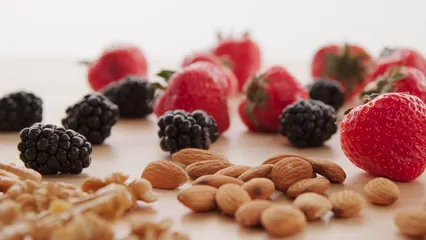Introduction
Raw food diets for dogs are gaining popularity. Many pet owners believe these diets mimic natural eating habits. However, understanding food safety is crucial. Raw diets can pose risks, such as bacterial infections and nutritional imbalances. Knowing the benefits and potential hazards helps ensure your dog stays healthy.
Speaking of staying healthy, make sure you have the right tools for measuring portions! A Pet Food Scale for Measuring Portions can help you accurately measure your dog’s food, ensuring they get just the right amount. After all, nobody wants a chubby puppy!

Summary and Overview
Raw food diets typically consist of uncooked meat, bones, fruits, and vegetables. These diets have surged in popularity, with studies showing 15-25% of dogs fed some form of raw food. While many owners report positive changes, such as shinier coats and improved energy, there are significant health risks. Common concerns include bacteria like Salmonella and E. coli, which can infect both pets and humans. Additionally, raw feeding can lead to nutritional deficiencies if not properly managed. It’s important to weigh these benefits against potential dangers before deciding on a raw diet for your pet.
To keep your dog’s food fresh and safe, consider investing in Dog Food Storage Containers. These containers are designed to keep food fresh while preventing pesky pests from getting a free meal. After all, your dog deserves the best, not a side of bugs!

Understanding Raw Food Diets
What Are Raw Food Diets?
Raw food diets, often referred to as RMBD (Raw Meat-Based Diets), focus on providing pets with uncooked, natural ingredients. These diets typically include muscle meat, bones, organ meats, fruits, and vegetables. The philosophy behind raw feeding is to mimic the diet of a dog’s wild ancestors, promoting a more “natural” way of eating. Proponents argue that this approach can lead to better health outcomes, including improved digestion, healthier skin, and cleaner teeth. However, it’s essential to ensure that these diets are balanced and meet all nutritional needs. Consulting with a veterinarian or a pet nutritionist is highly recommended before transitioning to a raw diet.
For those looking to dive deeper into raw feeding, a Raw Dog Food Recipe Book can provide you with tasty and nutritious recipes that will make your dog drool with excitement. Just remember, a recipe is only as good as the ingredients you use!

Types of Raw Diets
Raw diets for dogs can be prepared at home or purchased commercially. Home-prepared diets allow owners to control ingredients but require careful planning to ensure nutritional balance. Many pet parents opt for a more convenient route with commercially prepared raw food. These options often follow strict safety and quality standards.
Among the types of raw diets, the BARF diet—short for Biologically Appropriate Raw Food—has gained popularity. This approach emphasizes raw meat, bones, fruits, and vegetables. It aims to mimic the natural diet of wild canines. Another choice is freeze-dried raw food, which retains nutritional value while being easy to store and handle. If you want to keep things simple, check out Freeze-Dried Raw Dog Food. It’s like the fast food of raw diets, but healthier!
Each diet has its pros and cons. Home-prepared diets may lack essential nutrients without proper guidance. Commercial options can sometimes be costly, but they provide convenience and safety. Always consult with a veterinarian before making dietary changes to ensure your dog’s health needs are met.

Health Risks Associated with Raw Food
Bacterial Contamination
Bacterial contamination is a significant concern when feeding dogs raw food. Common pathogens such as Salmonella, E. coli, and Listeria can be present in raw meats. A study found that nearly 25% of raw dog food samples tested positive for harmful bacteria. Another report indicated that 20% of raw pet food products contained Salmonella. These bacteria not only pose a risk to pets but also to humans, especially in households with children or immunocompromised individuals.
The CDC and FDA have expressed concerns regarding these pathogens. Proper food handling can help reduce risks, but even careful practices may not eliminate the threat entirely. Awareness of contamination rates is crucial for pet owners considering raw diets. To help manage food safety, consider adding a Pet Food Thermometer to your kitchen arsenal. This handy tool ensures that your dog’s food is served at the right temperature, making mealtime safe and enjoyable!

Potential Health Effects on Dogs
Dogs consuming contaminated raw food can exhibit severe symptoms. Common signs of bacterial infections include vomiting, diarrhea (often bloody), fever, and lethargy. In some cases, dogs may carry pathogens without showing signs, posing a risk to family members.
For dogs with compromised immune systems, the risks are even higher. These pets may experience more severe health issues, making it vital to monitor their health closely. Always consult a veterinarian if your dog shows symptoms after consuming raw food. Taking proactive steps can help protect both your pet and your family from potential health hazards associated with raw diets.

Nutritional Considerations
Balancing Nutritional Needs
A balanced diet is crucial for your dog’s health. Raw diets can lead to common deficiencies. Essential nutrients include vitamins, minerals, and amino acids. Without a proper balance, your dog may suffer from health issues. Some deficiencies might not show symptoms immediately, making them hard to spot.
Consulting a veterinary nutritionist is essential. They can help create a diet plan that meets your dog’s specific needs. A nutritionist will evaluate your dog’s age, weight, and health status. Working with them ensures your pet receives a complete diet, avoiding potential pitfalls of raw feeding. To support your dog’s health, consider adding Dog Vitamins and Supplements to their diet. It can help fill in any nutritional gaps and keep your furry friend thriving!

Evaluating Commercial Raw Diets
When selecting a commercial raw diet, several factors are vital. First, check for AAFCO approval, which ensures the diet meets nutritional standards. Look for labels that specify it is “complete and balanced.” This guarantees the food contains all necessary nutrients for your dog.
Also, consider the source of ingredients. Quality matters, and reputable brands often use high-quality meats and produce. Pay attention to any recalls or safety alerts associated with the product. A well-chosen commercial raw diet can provide convenience and peace of mind for pet owners. And if you’re ever in doubt, consider investing in a Pet Food Safety Guide Book. Knowledge is power, and this book can help you make informed decisions!

Reducing Cross-Contamination Risks
Preventing cross-contamination is vital, especially in homes with children or those who are immunocompromised. Here are some practical tips to keep your family safe:
- Keep Raw Food Separate: Always store raw dog food away from human food. Use dedicated containers to avoid any contact. This helps prevent bacteria from spreading.
- Use Separate Utensils: Designate specific utensils for handling raw pet food. Avoid using these utensils for human food preparation to minimize contamination risks.
- Thorough Cleaning Routines: Clean all surfaces and utensils immediately after use. Use hot, soapy water followed by disinfectants to eliminate harmful bacteria.
- Hand Hygiene: Wash your hands thoroughly after handling raw food. This simple step can significantly reduce the chances of transferring bacteria.
- Educate Household Members: Ensure everyone in the home understands the importance of hygiene around raw food. Teach children to avoid touching raw pet food and to wash their hands afterward.
By implementing these practices, you can enjoy the benefits of raw feeding while keeping your household safe from potential contamination. And let’s not forget about your furry friend’s comfort! A Dog Bed for Comfort can make a world of difference in their overall happiness and health!

Expert Opinions and Recommendations
Veterinary Perspectives
Veterinary associations like the AVMA and CDC caution against raw diets for dogs. They emphasize that raw meat can harbor dangerous pathogens like Salmonella and E. coli. These bacteria can affect both pets and humans. The FDA also advises against raw feeding due to these risks.
Before switching your dog’s diet, consulting a veterinarian is essential. A professional can provide tailored advice based on your pet’s health needs. They can also help ensure the new diet is balanced and safe.
Veterinarians recommend adopting diets processed to eliminate harmful bacteria. This approach helps protect both pet and owner health. While raw diets may seem appealing, informed decisions based on expert advice are crucial for your pet’s wellbeing. And speaking of wellbeing, don’t forget to keep your dog’s teeth healthy with some Dog Dental Chews. They’ll help keep that tail wagging and those teeth sparkling!

Case Studies and Anecdotal Evidence
Many raw diet proponents report benefits like shinier coats and improved energy levels. However, these claims often lack scientific backing. Case studies show mixed results regarding raw feeding’s effectiveness. Some dogs thrive on raw diets, while others face health issues.
Conversely, studies consistently highlight the risks of bacterial contamination. For example, research indicates a significant presence of Salmonella in raw pet foods. This poses risks not just for dogs but also for human family members.
In summary, while some anecdotal evidence supports raw diets, it’s essential to weigh these claims against scientific findings. A balanced view considers both potential benefits and serious health risks.

Conclusion
In conclusion, understanding raw food safety for dogs is vital. We discussed the risks, including bacterial contamination and nutritional deficiencies. It’s essential to make informed decisions about your dog’s diet. Consulting with a veterinarian can help guide you towards safe practices. Always prioritize the health of your pet and family. Encourage safe handling and awareness of potential risks. Your dog’s health is worth the effort!

FAQs
What are the main risks of feeding my dog raw food?
Feeding dogs raw food comes with several risks. Bacterial contamination is a significant concern. Common pathogens like Salmonella and E. coli can be present in raw meat. These bacteria may lead to infections in both pets and humans. Additionally, raw diets can result in nutritional imbalances. Without proper planning, your dog might miss essential nutrients. Overall, the risks can be serious, so proceed with caution.
How can I ensure my dog’s raw diet is balanced?
To maintain a balanced raw diet, consult your veterinarian. They can help create a tailored meal plan. Consider using commercially prepared raw food options. These often meet nutritional standards and simplify meal preparation. Ensure your dog receives the right mix of proteins, veggies, and supplements. Regular check-ups can help monitor your dog’s health and dietary needs.
What hygiene practices should I follow when handling raw dog food?
When handling raw dog food, strict hygiene is essential. Always wash your hands with soap and water after touching raw meat. Clean all surfaces and utensils immediately to prevent cross-contamination. Use separate containers for raw food storage. When defrosting, keep raw food away from other items. These practices help minimize the risk of spreading harmful bacteria.
Are there any benefits to feeding dogs a raw diet?
Supporters of raw diets often report benefits like shinier coats and improved energy. They believe these diets mimic ancestral eating habits. However, scientific evidence supporting these claims is limited. Some studies suggest raw diets may enhance digestion and stool quality. Still, it’s crucial to weigh these anecdotal benefits against the potential health risks and nutritional concerns.
Should I be concerned about raw food affecting my family’s health?
Yes, raw food can pose health risks to your family. Bacteria like Salmonella can spread from raw pet food to humans. This is especially concerning for households with children or immunocompromised individuals. To minimize risks, practice strict hygiene when handling raw food. Always wash hands and clean surfaces thoroughly after contact with pet food.
What should I do if my dog shows symptoms after eating raw food?
If your dog exhibits symptoms like vomiting or diarrhea after eating raw food, consult your veterinarian immediately. They can assess your dog’s condition and recommend appropriate treatment. Be prepared to provide details about the diet and any specific symptoms observed. Early intervention can help prevent serious health issues.
Are there specific breeds that should avoid raw diets?
Certain breeds may be more susceptible to the risks associated with raw diets. Breeds with sensitive digestive systems or specific health concerns should approach raw feeding with caution. Always consult your veterinarian before introducing raw food to your dog’s diet. They can provide guidance based on your dog’s breed, age, and overall health.
Please let us know what you think about our content by leaving a comment down below!
Thank you for reading till here 🙂
For those interested in the benefits of raw feeding, it’s essential to understand the complete picture. Check out this comprehensive guide on the raw feeding benefits.
If you’re a new pet owner, it’s crucial to manage your dog’s anxiety effectively. Consider reading this guide for new dog owners on managing separation anxiety in rescue dogs.
All images from Pexels





